Comprehensive Enhancement in Thermomechanical Performance of Melt-Extruded PEEK Filaments by Graphene Incorporation
Abstract
:1. Introduction
2. Materials and Methods
2.1. Materials
2.2. Fabrication of PEEK–GnP Nanocomposites
2.2.1. Adsorption of GnPs on the Surface of PEEK
2.2.2. Extrusion of Filaments of the PEEK–GnP Nanocomposites
2.3. Characterization
3. Results and Discussion
3.1. Morphology Observation
3.2. Characteristics of Molecular Structure
3.3. Thermal Analyses
3.4. Thermomechanical Properties
3.5. Theoretical Modeling of the Mechanical Properties of the PEEK–GnP Nanocomposites
4. Conclusions
Supplementary Materials
Author Contributions
Funding
Institutional Review Board Statement
Informed Consent Statement
Acknowledgments
Conflicts of Interest
References
- Gao, S.L.; Kim, J.K. Cooling Rate Influences in Carbon fibre/PEEK Composites. Part III: Impact Damage Performance. Compos. Part A Appl. Sci. Manuf. 2001, 32, 775–785. [Google Scholar] [CrossRef]
- Li, E.Z.; Guo, W.L.; Wang, H.D.; Xu, B.S.; Liu, X.T. Research on Tribological Behavior of PEEK and Glass Fiber Reinforced PEEK Composite. Phys. Procedia 2013, 50, 453–460. [Google Scholar] [CrossRef] [Green Version]
- Cantwell, W.J.; Morton, J. The Impact Resistance of Composite Materials—A Review. Composites 1991, 22, 347–362. [Google Scholar] [CrossRef]
- Kumar, D.; Rajmohan, T.; Venkatachalapathi, S. Wear Behavior of PEEK Matrix Composites: A Review. Mater. Today Proc. 2018, 5, 14583–14589. [Google Scholar] [CrossRef]
- Zhang, Z.; Breidt, C.; Chang, L.; Friedrich, K. Wear of PEEK Composites Related to Their Mechanical Performances. Tribol. Int. 2004, 37, 271–277. [Google Scholar] [CrossRef]
- Puértolas, J.A.; Castro, M.; Morris, J.A.; Ríos, R.; Ansón-Casaos, A. Tribological and Mechanical Properties of Graphene Nanoplatelet/PEEK Composites. Carbon 2019, 141, 107–122. [Google Scholar] [CrossRef] [Green Version]
- Soutis, C. Carbon Fiber Reinforced Plastics in Aircraft Construction. Mater. Sci. Eng. A 2005, 412, 171–176. [Google Scholar] [CrossRef]
- Li, C.S.; Vannabouathong, C.; Sprague, S.; Bhandari, M. The Use of Carbon-Fiber-Reinforced (CFR) Peek Material in Orthopedic Implants: A Systematic Review. Clin. Med. Insights Arthritis Musculoskelet. Disord. 2014, 8, 33–45. [Google Scholar] [CrossRef]
- Sandler, J.; Werner, P.; Shaffer, M.S.P.; Demchuk, V.; Altsta, V.; Windle, A.H. Carbon-Nanofibre-Reinforced Poly (Ether Ether Ketone ). Composites 2002, 33, 1033–1039. [Google Scholar] [CrossRef]
- Hassan, E.A.M.; Yang, L.; Elagib, T.H.H.; Ge, D.; Lv, X.; Zhou, J.; Yu, M.; Zhu, S. Synergistic Effect of Hydrogen Bonding and π-π Stacking in Interface of CF/PEEK Composites. Compos. Part B Eng. 2019, 171, 70–77. [Google Scholar] [CrossRef]
- Lin, L.; Ecke, N.; Huang, M.; Pei, X.-Q.; Schlarb, A.K. Impact of Nanosilica on the Friction and Wear of a PEEK/CF Composite Coating Manufactured by Fused Deposition Modeling (FDM). Compos. Part B Eng. 2019, 177, 107428. [Google Scholar] [CrossRef]
- Zhu, S.; Qian, Y.; Hassan, E.A.M.; Shi, R.; Yang, L.; Cao, H.; Zhou, J.; Ge, D.; Yu, M. Enhanced interfacial interactions by PEEK-grafting and coupling of acylated CNT for GF/PEEK composites. Compos. Commun. 2020, 18, 43–48. [Google Scholar] [CrossRef]
- Bangarusampath, D.S.; Ruckdäschel, H.; Altstädt, V.; Sandler, J.K.W.; Garray, D.; Shaffer, M.S.P. Rheology and Properties of Melt-processed Poly (Ether Ether Ketone)/Multi-Wall Carbon Nanotube Composites. Polymer 2009, 50, 5803–5811. [Google Scholar] [CrossRef]
- Mohiuddin, M.; Hoa, S.V. Temperature Dependent Electrical Conductivity of CNT-PEEK Composites. Compos. Sci. Technol. 2011, 72, 21–27. [Google Scholar] [CrossRef]
- Tishkova, V.; Raynal, P.I.; Puech, P.; Lonjon, A.; Le Fournier, M.; Demont, P.; Flahaut, E.; Bacsa, W. Electrical conductivity and Raman imaging of double wall carbon nanotubes in a polymer matrix. Compos. Sci. Technol. 2011, 71, 1326–1330. [Google Scholar] [CrossRef] [Green Version]
- Díez-Pascual, A.M.; Ashrafi, B.; Naffakh, M.; González-Domínguez, J.M.; Johnston, A.; Simard, B.; Martínez, M.T.; Gómez-Fatou, M.A. Influence of Carbon Nanotubes on the Thermal, Electrical and Mechanical Properties of Poly (Ether Ether Ketone)/Glass Fiber Laminates. Carbon 2011, 49, 2817–2833. [Google Scholar] [CrossRef] [Green Version]
- Yaragalla, S.; Rajendran, R.; AlMaadeed, M.A.; Kalarikkal, N.; Thomas, S. Chemical Modification of Graphene with Grape Seed Extract: Its Structural, Optical and Antimicrobial Properties. Mater. Sci. Eng. C 2019, 102, 305–314. [Google Scholar] [CrossRef] [PubMed]
- Tewatia, A.; Hendrix, J.; Dong, Z.; Taghon, M.; Tse, S.; Chiu, G.; Mayo, W.E.; Kear, B.; Nosker, T.; Lynch, J. Characterization of Melt-Blended Graphene—Poly (ether ether ketone) Nanocomposite. Mater. Sci. Eng. B 2017, 216, 41–49. [Google Scholar] [CrossRef] [Green Version]
- King, J.A.; Tomasi, J.M.; Klimek-McDonald, D.R.; Miskioglu, I.; Odegard, G.M.; King, T.R.; Sutherland, J.W. Effects of Carbon Fillers on the Conductivity and Tensile Properties of Polyetheretherketone Composites. Polym. Compos. 2018, 39, E807–E816. [Google Scholar] [CrossRef]
- He, M.; Chen, X.; Guo, Z.; Qiu, X.; Yang, Y.; Su, C.; Jiang, N.; Li, Y.; Sun, D.; Zhang, L. Super Tough Graphene Oxide Reinforced Polyetheretherketone for Potential Hard Tissue Repair Applications. Compos. Sci. Technol. 2019, 174, 194–201. [Google Scholar] [CrossRef] [Green Version]
- Lee, C.; Wei, X.; Kysar, J.W.; Hone, J. Measurement of the Elastic Properties and Intrinsic Strength of Monolayer Graphene. Science 2008, 321, 385–388. [Google Scholar] [CrossRef] [PubMed]
- Ghosh, S.; Calizo, I.; Teweldebrhan, D.; Pokatilov, E.P.; Nika, D.L.; Balandin, A.A.; Bao, W.; Miao, F.; Lau, C.N. Extremely High Thermal Conductivity of Graphene: Prospects for Thermal Management Applications in Nanoelectronic Circuits. Appl. Phys. Lett. 2008, 92, 151911. [Google Scholar] [CrossRef]
- Nirmalraj, P.N.; Lutz, T.; Kumar, S.; Duesberg, G.S.; Boland, J.J. Nanoscale Mapping of Electrical Resistivity and Connectivity in Graphene Strips and Networks. Nano Lett. 2011, 11, 16–22. [Google Scholar] [CrossRef]
- Kuilla, T.; Bhadra, S.; Yao, D.; Kim, N.H.; Bose, S.; Lee, J.H. Recent Advances in Graphene Based Polymer Composites. Prog. Polym. Sci. 2010, 35, 1350–1375. [Google Scholar] [CrossRef]
- Hwang, Y.; Kim, M.; Kim, J. Improvement of the Mechanical Properties and Thermal Conductivity of Poly (Ether-Ether-Ketone) with the Addition of Graphene Oxide-Carbon Nanotube Hybrid Fillers. Compos. Part A Appl. Sci. Manuf. 2013, 55, 195–202. [Google Scholar] [CrossRef]
- Sarno, M.; Baldino, L.; Scudieri, C.; Cardea, S.; Ciambelli, P.; Reverchon, E. SC-CO2-Assisted Process for a High Energy Density Aerogel Supercapacitor: The effect of GO loading. Nanotechnology 2017, 28. [Google Scholar] [CrossRef]
- Dideikin, A.T.; Vul’, A.Y. Graphene Oxide and Derivatives: The Place in Graphene Family. Front Phys. 2019, 6. [Google Scholar] [CrossRef]
- Serrano-Luján, L.; Víctor-Román, S.; Toledo, C.; Sanahuja-Parejo, O.; Mansour, A.E.; Abad, J.; Amassian, A.; Benito, A.M.; Maser, W.K.; Urbina, A. Environmental Impact of the Production of Graphene Oxide and Reduced Graphene Oxide. SN Appl. Sci. 2019, 1. [Google Scholar] [CrossRef] [Green Version]
- Kauling, A.P.; Seefeldt, A.T.; Pisoni, D.P.; Pradeep, R.C.; Bentini, R.; Oliveira, R.V.B.; Novoselov, K.S.; Castro Neto, A.H. The Worldwide Graphene Flake Production. Adv. Mater. 2018, 30, 1803784–1803789. [Google Scholar] [CrossRef] [PubMed]
- Del Rio Castillo, A.E.; Pellegrini, V.; Ansaldo, A.; Ricciardella, F.; Sun, H.; Marasco, L.; Buha, J.; Dang, Z.; Gagliani, L.; Lago, E.; et al. High-Yield Production of 2D crystals by Wet-Jet Milling. Mater. Horiz. 2018, 5, 890–904. [Google Scholar] [CrossRef] [Green Version]
- Xu, Y.; Cao, H.; Xue, Y.; Li, B.; Cai, W. Liquid-Phase Exfoliation of Graphene: An Overview on Exfoliation Media, Techniques, and Challenges. Nanomaterials 2018, 8, 942. [Google Scholar] [CrossRef] [PubMed] [Green Version]
- Kovtun, A.; Treossi, E.; Mirotta, N.; Scidà, A.; Liscio, A.; Christian, M.; Valorosi, F.; Boschi, A.; Young, R.J.; Galiotis, C.; et al. Benchmarking of Graphene-Based Materials: Real Commercial Products Versus Ideal Graphene. 2D Mater. 2019, 6. [Google Scholar] [CrossRef]
- Zahid, M.; Masood, M.T.; Athanassiou, A.; Bayer, I.S. Sustainable Thermal Interface Materials from Recycled Cotton Textiles and Graphene Nanoplatelets. Appl. Phys. Lett. 2018, 113, 44103. [Google Scholar] [CrossRef]
- Cataldi, P.; Bayer, I.S.; Nanni, G.; Athanassiou, A.; Bonaccorso, F.; Pellegrini, V.; del Rio Castillo, A.E.; Ricciardella, F.; Artyukhin, S.; Tronche, M.A.; et al. Effect of Graphene Nano-Platelet Morphology on the Elastic Modulus of Soft and Hard Biopolymers. Carbon 2016, 109, 331–339. [Google Scholar] [CrossRef]
- La Mantia, F.P.; Dintcheva, N.T.; Scaffaro, R.; Marino, R. Morphology and Properties of Polyethylene/Clay Nanocomposite Drawn Fibers. Macromol. Mater. Eng. 2008, 293, 83–91. [Google Scholar] [CrossRef]
- Díez-Pascual, A.M.; Naffakh, M.; González-Domínguez, J.M.; Ansón, A.; Martínez-Rubi, Y.; Martínez, M.T.; Simard, B.; Gómez, M. A High Performance PEEK/Carbon Nanotube Composites Compatibilized with Polysulfones-II. Mechanical and Electrical Properties. Carbon 2010, 48, 3500–3511. [Google Scholar] [CrossRef]
- Li, D.; Wang, L.; Liu, S.; Ren, X.; Han, X. Preparation of Sulfonated Poly (Ether Ether Ketone)/Graphene Oxide Blend Membranes and Their Application in Vanadium Redox Flow Battery. ACTA Polym. Sin. 2015, 1280–1287. [Google Scholar]
- Li, H.; Zhang, B.; Liu, W.; Lin, B.; Ou, Q.; Wang, H.; Fang, M.; Liu, D.; Neelakandan, S.; Wang, L. Effects of an Electrospun Fluorinated Poly (Ether Ether Ketone) Separator on the Enhanced Safety and Electrochemical Properties of Lithium Ion Batteries. Electrochim. Acta 2018, 290, 150–164. [Google Scholar] [CrossRef]
- Yang, L.; Ohki, Y.; Hirai, N.; Hanada, S. Aging of Poly (Ether Ether Ketone) by Heat and Gamma Rays–Its Degradation Mechanism and Effects on Mechanical, Dielectric and Thermal Properties. Polym. Degrad. Stab. 2017, 142, 117–128. [Google Scholar] [CrossRef]
- Alhwaige, A.A.; Alhassan, S.M.; Katsiotis, M.S.; Ishida, H.; Qutubuddin, S. Interactions, Morphology and Thermal Stability of Graphene-Oxide Reinforced Polymer Aerogels Derived from Star-Like Telechelic Aldehyde-Terminal Benzoxazine Resin. RSC Adv. 2015, 5, 92719–92731. [Google Scholar] [CrossRef]
- Mitra, M.; Kulsi, C.; Chatterjee, K.; Kargupta, K.; Ganguly, S.; Banerjee, D.; Goswami, S. Reduced Graphene Oxide-Polyaniline Composites—Synthesis, Characterization and Optimization for Thermoelectric Applications. RSC Adv. 2015, 5, 31039–31048. [Google Scholar] [CrossRef]
- Puhan, D.; Wong, J.S.S. Properties of Polyetheretherketone (PEEK) Transferred Materials in a PEEK-Steel Contact. Tribol. Int. 2019, 135. [Google Scholar] [CrossRef]
- Berer, M.; Major, Z.; Pinter, G. Elevated Pitting Wear of Injection Molded Polyetheretherketone (PEEK) Rolls. Wear 2013, 297, 1052–1063. [Google Scholar] [CrossRef]
- Childres, I.; Jauregui, L.A.; Park, W.; Caoa, H.; Chena, Y.P. Raman Spectroscopy of Graphene and Related Materials. New Dev. Phot. Mater. Res. 2013, 1, 1–20. [Google Scholar]
- Ferrari, A.C.; Meyer, J.C.; Scardaci, V.; Casiraghi, C.; Lazzeri, M.; Mauri, F.; Piscanec, S.; Jiang, D.; Novoselov, K.S.; Roth, S.; et al. Raman Spectrum of Graphene and Graphene Layers. Phys. Rev. Lett. 2006, 97, 187401. [Google Scholar] [CrossRef] [PubMed] [Green Version]
- Masood, M.T.; Zahid, M.; Goldoni, L.; Ceseracciu, L.; Athanassiou, A.; Bayer, I.S. Highly Transparent Polyethylcyanoacrylates from Approved Eco-Friendly Fragrance Materials Demonstrating Excellent Fog-Harvesting and Anti-Wear Properties. ACS Appl. Mater. Interfaces 2018, 10, 34573–34584. [Google Scholar] [CrossRef]
- Yazdani, B.; Xia, Y.; Ahmad, I.; Zhu, Y. Graphene and Carbon Nanotube (GNT)-Reinforced Alumina Nanocomposites. J. Eur. Ceram. Soc. 2015, 35, 179–186. [Google Scholar] [CrossRef]
- Muniz, F.T.L.; Miranda, M.A.R.; Morilla Dos Santos, C.; Sasaki, J.M. The Scherrer Equation and the Dynamical Theory of X-ray Diffraction. Acta Crystallogr. Sect. A Found. Adv. 2016. [Google Scholar] [CrossRef]
- Cui, Y.; Kundalwal, S.I.; Kumar, S. Gas Barrier Performance of Graphene/Polymer Nanocomposites. Carbon 2016, 98, 313–333. [Google Scholar] [CrossRef] [Green Version]
- Yang, J.; Huang, Y.; Lv, Y.; Zhao, P.; Yang, Q.; Li, G. The Intrinsic Thermal-Oxidative Stabilization Effect of Chemically Reduced Graphene Oxide on Polypropylene. J. Mater. Chem. A 2013, 1, 11184. [Google Scholar] [CrossRef]
- Patel, P.; Hull, T.R.; McCabe, R.W.; Flath, D.; Grasmeder, J.; Percy, M. Mechanism of Thermal Decomposition of Poly (Ether Ether Ketone) (PEEK) from a Review of Decomposition Studies. Polym. Degrad. Stab. 2010, 95, 709–718. [Google Scholar] [CrossRef] [Green Version]
- Alvaredo, Á.; Martín, M.; Castell, P.; Guzmán de Villoria, R.; Fernández-Blázquez, J. Non-Isothermal Crystallization Behavior of PEEK/Graphene Nanoplatelets Composites from Melt and Glass States. Polymers 2019, 11, 124. [Google Scholar] [CrossRef] [Green Version]
- Díez-Pascual, A.M.; Naffakh, M.; Gómez, M.A.; Marco, C.; Ellis, G.; González-Domínguez, J.M.; Ansón, A.; Martínez, M.T.; Martínez-Rubi, Y.; Simard, B. The Influence of a Compatibilizer on the Thermal and Dynamic Mechanical Properties of PEEK/Carbon Nanotube Composites. Nanotechnology 2009, 20, 315707. [Google Scholar] [CrossRef] [PubMed]
- Yaragalla, S.; Meera, A.P.; Kalarikkal, N.; Thomas, S. Chemistry associated with natural rubber–graphene nanocomposites and its effect on physical and structural properties. Ind. Crops. Prod. 2015, 74, 792–802. [Google Scholar] [CrossRef]
- Papageorgiou, D.G.; Kinloch, I.A.; Young, R.J. Mechanical Properties of Graphene and Graphene-Based Nanocomposites. Prog. Mater. Sci. 2017, 90, 75–127. [Google Scholar] [CrossRef]
- Manikas, A.C.; Pastore Carbone, M.G.; Woods, C.R.; Wang, Y.; Souli, I.; Anagnostopoulos, G. Stress Transfer at the Nanoscale on Graphene Ribbons of Regular Geometry. Nanoscale 2019, 11, 14354–14361. [Google Scholar] [CrossRef] [PubMed]
- Androulidakis, C.; Sourlantzis, D.; Koukaras, E.N.; Manikas, A.C.; Galiotis, C. Stress-Transfer from Polymer Substrates to Monolayer and Few-Layer Graphenes. Nanoscale Adv. 2019, 1, 4972–4980. [Google Scholar] [CrossRef] [Green Version]
- Wang, P.; Ma, R.; Wang, Y.; Cao, W.; Liu, C.; Shen, C. Comparative Study of Fullerenes and Graphene Nanoplatelets on the Mechanical and Thermomechanical Properties of Poly (Ether Ether Ketone). Mater. Lett. 2019, 249, 180–184. [Google Scholar] [CrossRef]
- Li, S.; Li, J.; Ma, N.; Liu, D.; Sui, G. Super-Compression-Resistant Multiwalled Carbon Nanotube/Nickel-Coated Carbonized Loofah Fiber/Polyether Ether Ketone Composite with Excellent Electromagnetic Shielding Performance. ACS Sustain. Chem. Eng. 2019, 7, 13970–13980. [Google Scholar] [CrossRef]
- Young, R.J.; Kinloch, I.A.; Gong, L.; Novoselov, K.S. The Mechanics of Graphene Nanocomposites: A Review. Compos. Sci. Technol. 2012, 72, 1459–1476. [Google Scholar] [CrossRef]
- Yang, L.; Zhang, S.; Chen, Z.; Guo, Y.; Luan, J.; Geng, Z.; Wang, G. Design and Preparation of Graphene/Poly (Ether Ether Ketone) Composites with Excellent Electrical Conductivity. J. Mater. Sci. 2014, 49, 2372–2382. [Google Scholar] [CrossRef]
- Altstaedt, V.; Werner, P.; Sandler, J. Rheological, Mechanical and Tribological Properties of Carbon-Nanofibre Reinforced Poly (Ether Ether Ketone) Composites. Polímeros 2003, 13, 218–222. [Google Scholar] [CrossRef] [Green Version]
- Chan, K.W.; Liao, C.Z.; Wong, H.M.; Yeung, K.W.K.; Tjong, S.C. Preparation of Polyetheretherketone Composites with Nanohydroxyapatite Rods and Carbon Nanofibers Having High Strength, Good Biocompatibility and Excellent Thermal Stability. RSC Adv. 2016, 6, 19417–19429. [Google Scholar] [CrossRef]
- Nan, C.-W.; Shen, Y.; Ma, J. Physical Properties of Composites Near Percolation. Annu. Rev. Mater. Res. 2010, 40, 131–151. [Google Scholar] [CrossRef]
- Wu, Y.-P.; Jia, Q.-X.; Yu, D.-S.; Zhang, L.-Q. Modeling Young’s Modulus of Rubber–Clay Nanocomposites Using Composite Theories. Polym. Test 2004, 23, 903–909. [Google Scholar] [CrossRef]
- Mittal, V. Modeling of Tensile Modulus of Polyolefin-Layered Silicate Nanocomposites: Modified Halpin Tsai Models. Adv. Compos. Lett. 2012. [Google Scholar] [CrossRef] [Green Version]
- Halpin, J.C.; Kardos, J.L. The Halpin-Tsai Equations: A Review. Polym. Eng. Sci. 1976, 16, 344–352. [Google Scholar] [CrossRef]
- Lu, H.; Min Huang, W. Synergistic Effect of Self-Assembled Carboxylic Acid-Functionalized Carbon Nanotubes and Carbon Fiber for Improved Electro-Activated Polymeric Shape-Memory Nanocomposite. Appl. Phys. Lett. 2013, 102, 231910. [Google Scholar] [CrossRef]
- Zhou, H.; Heyer, P.; Kim, H.-J.; Song, J.-H.; Piao, L.; Kim, S.-H. Reversible Macroscopic Alignment of Ag Nanowires. Chem. Mater. 2011, 23, 3622–3627. [Google Scholar] [CrossRef]
- Lu, H.; Liang, F.; Gou, J. Nanopaper Enabled Shape-Memory Nanocomposite with Vertically Aligned Nickel Nanostrand: Controlled Synthesis and Electrical Actuation. Soft Matter. 2011, 16. [Google Scholar] [CrossRef]
- Yaragalla, S.; Rajendran, R.; Jose, J.; Almaadeed, M.A.; Kalarikkal, N.; Thomas, S. Preparation and characterization of green graphene using grape seed extract for bioapplications. Mater. Sci. Eng. C 2016, 65, 345–353. [Google Scholar] [CrossRef] [PubMed]
- Dave, K.; Park, K.H.; Dhayal, M. Characteristics of ultrasonication assisted assembly of gold nanoparticles in hydrazine reduced graphene oxide. RSC Adv. 2015, 5, 107348–107354. [Google Scholar] [CrossRef]
- James, W. The Optical Principles of the Diffraction of X-rays. In The Crystalline State; Bragg, W.L., Ed.; G. Bell and Sons Ltd.: London, UK, 1962; Volume II. [Google Scholar]
- Gómez-Navarro, C.; Burghard, M.; Kern, K. Elastic Properties of Chemically Derived Single Graphene Sheets. Nano Lett. 2008, 8, 2045–2049. [Google Scholar] [CrossRef] [PubMed] [Green Version]
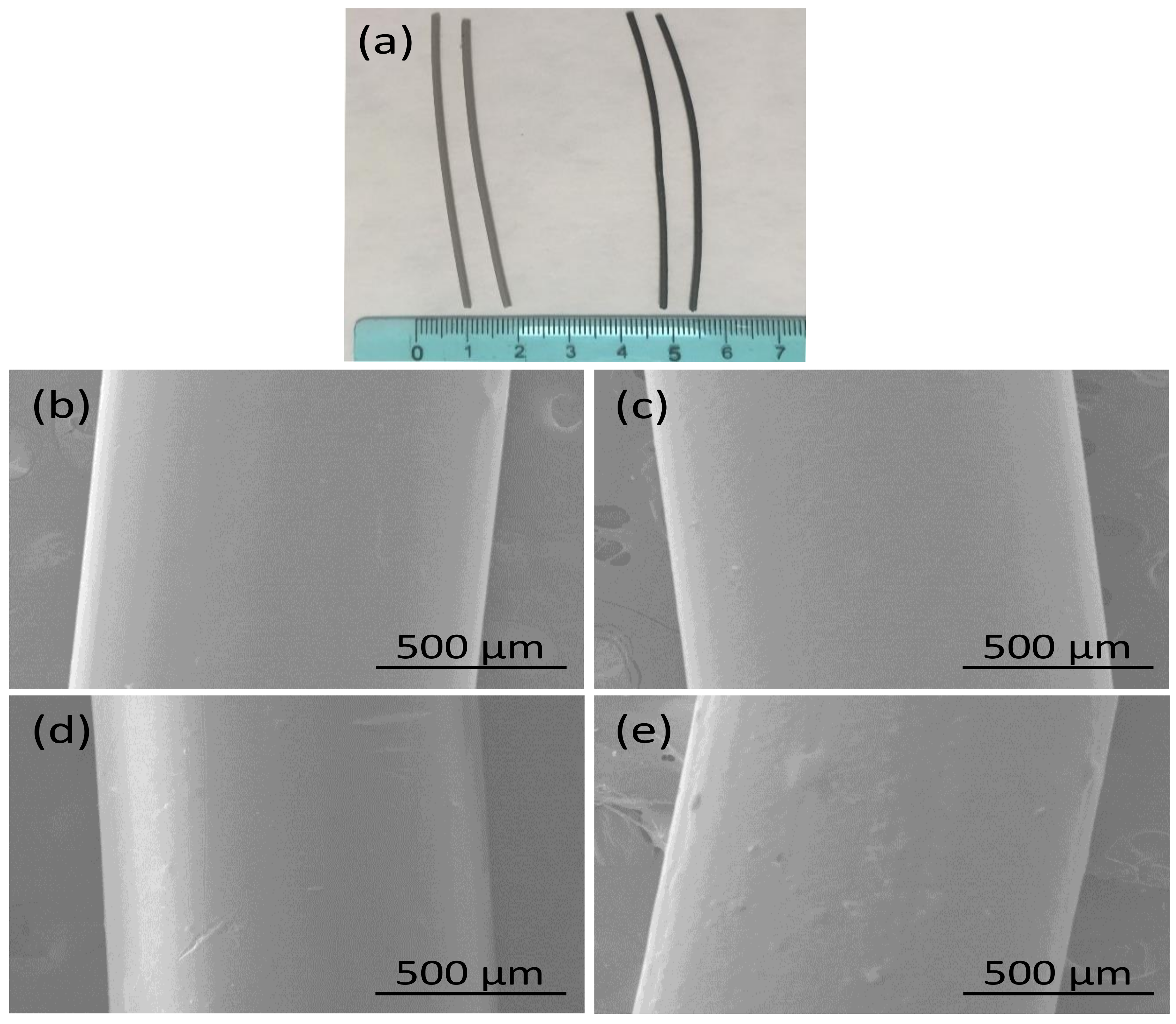
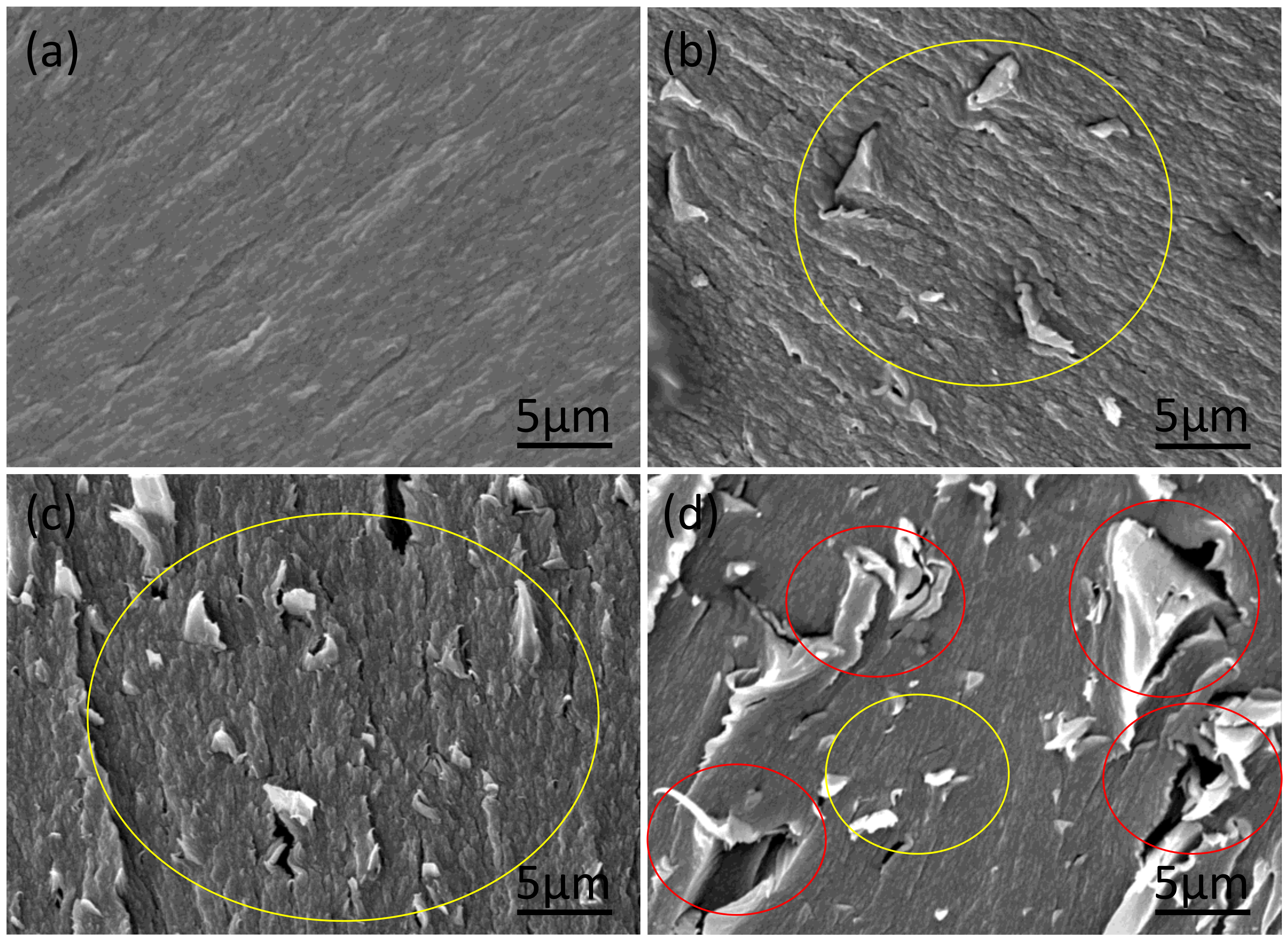
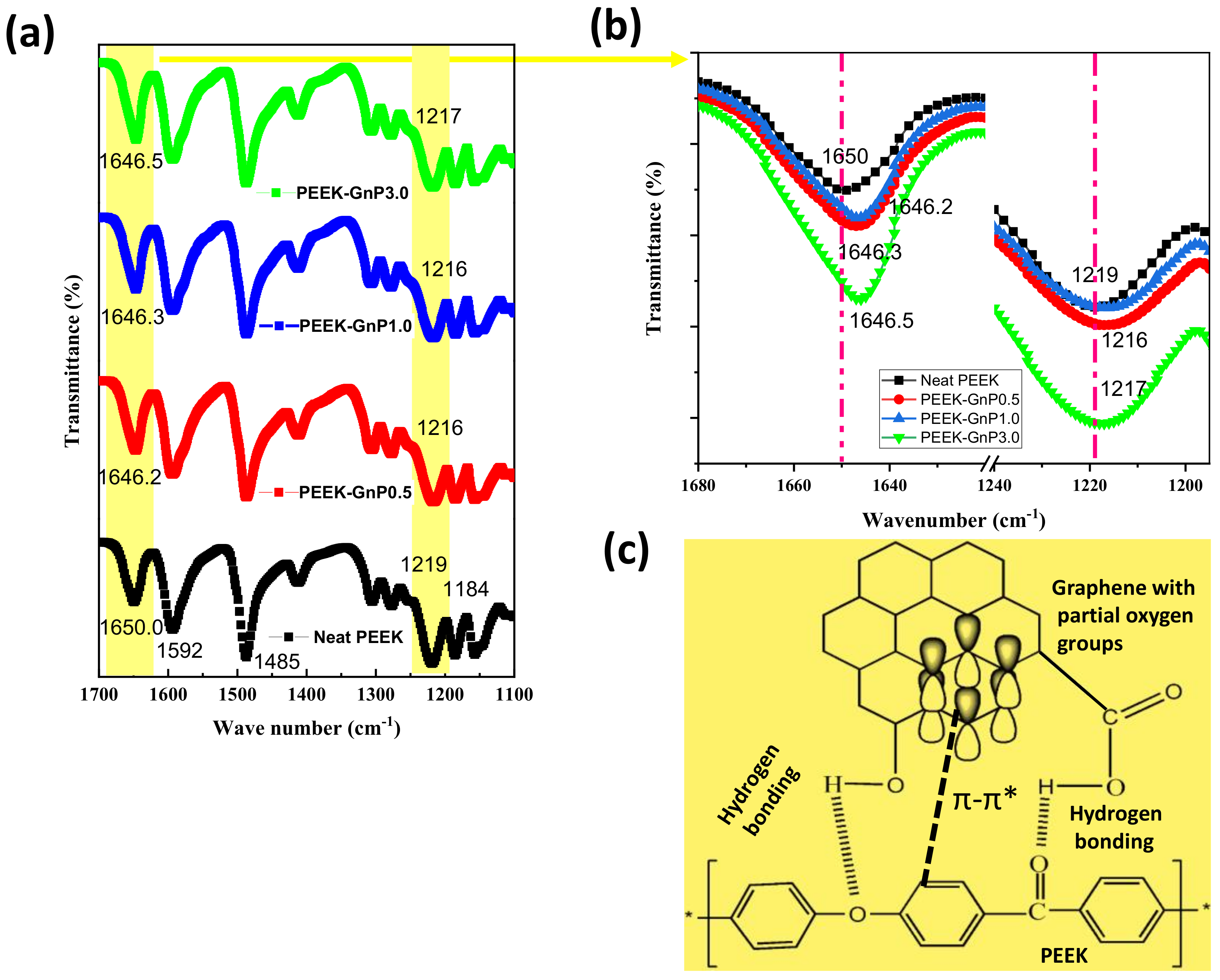
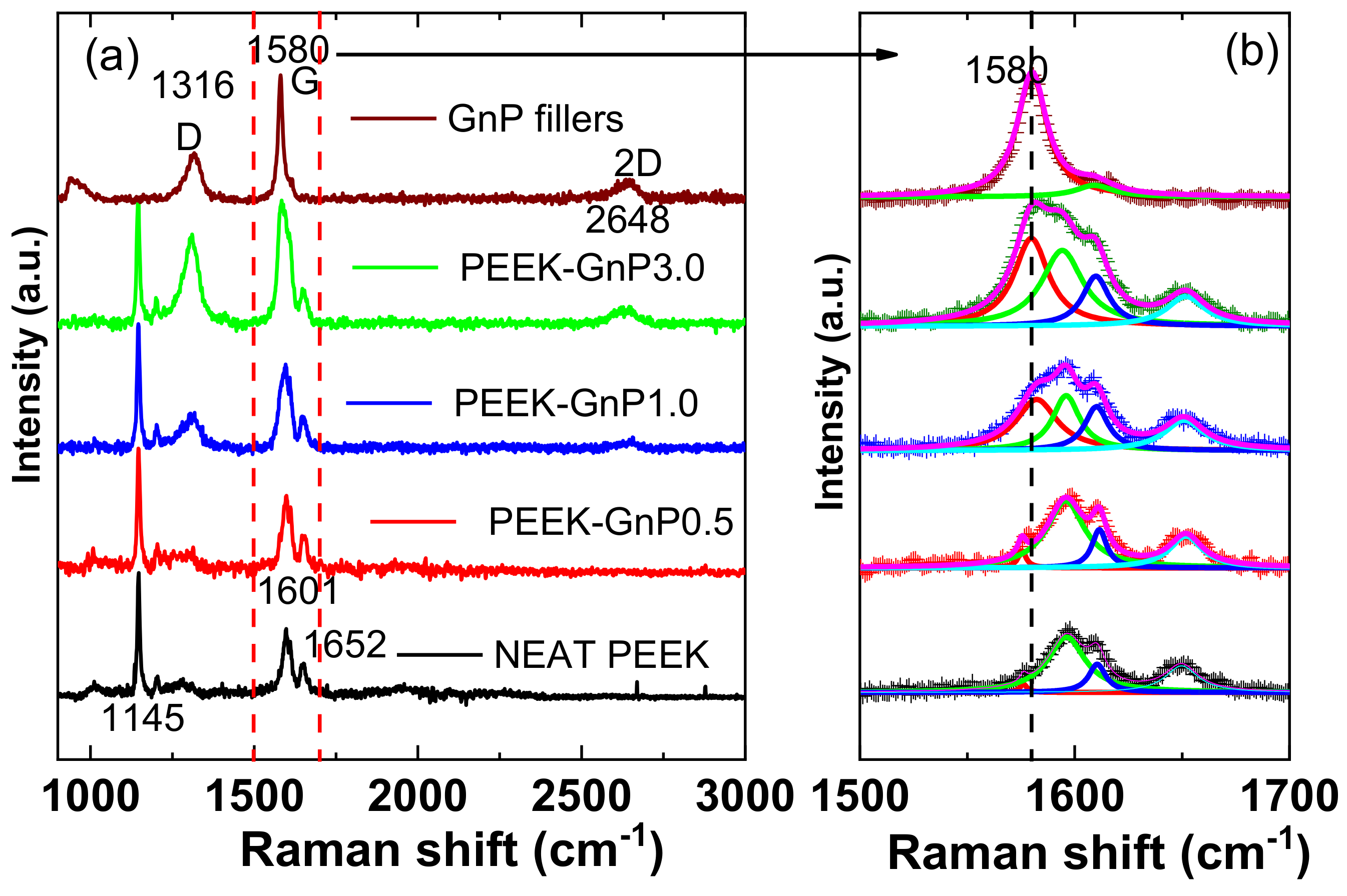
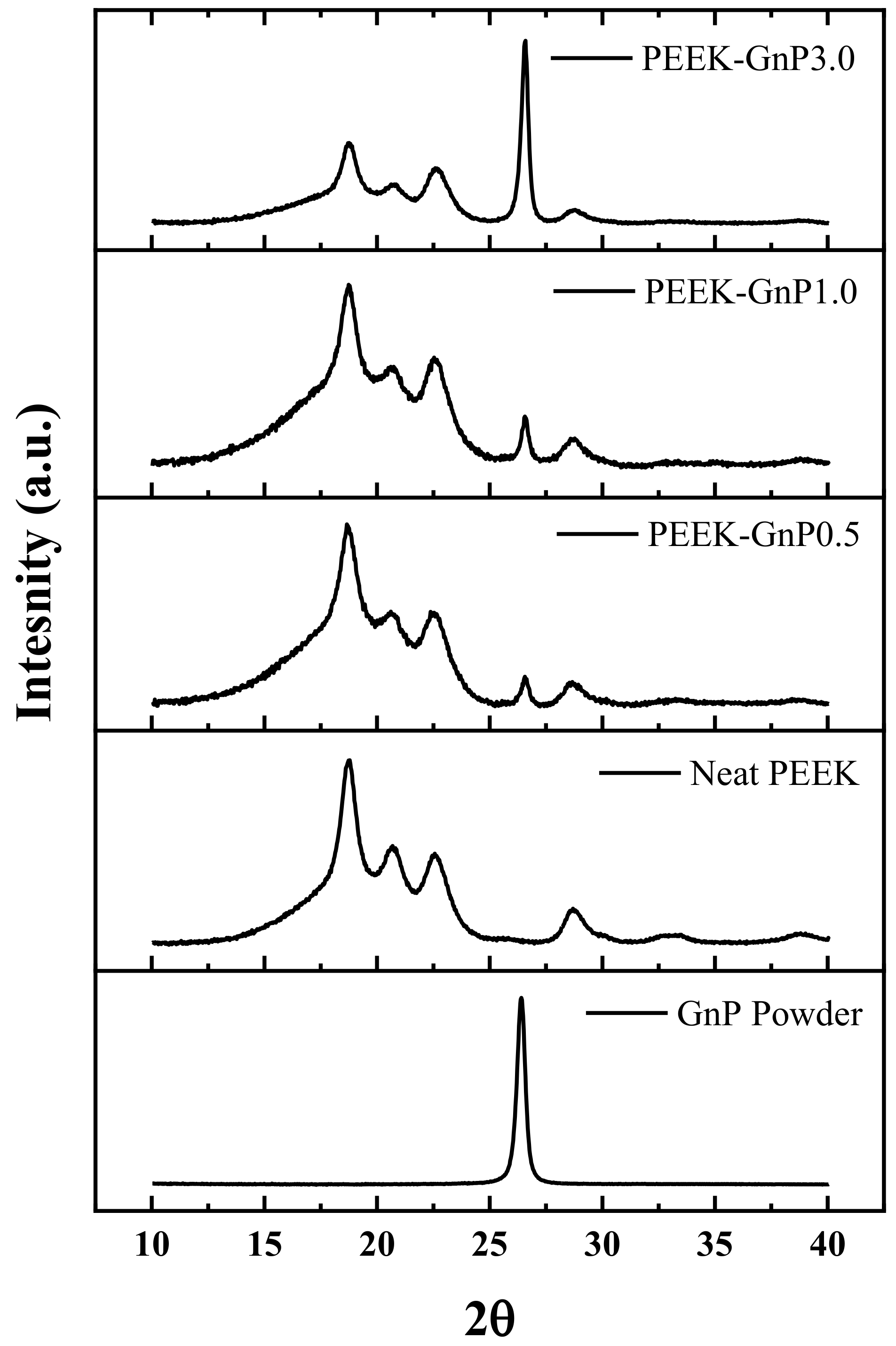
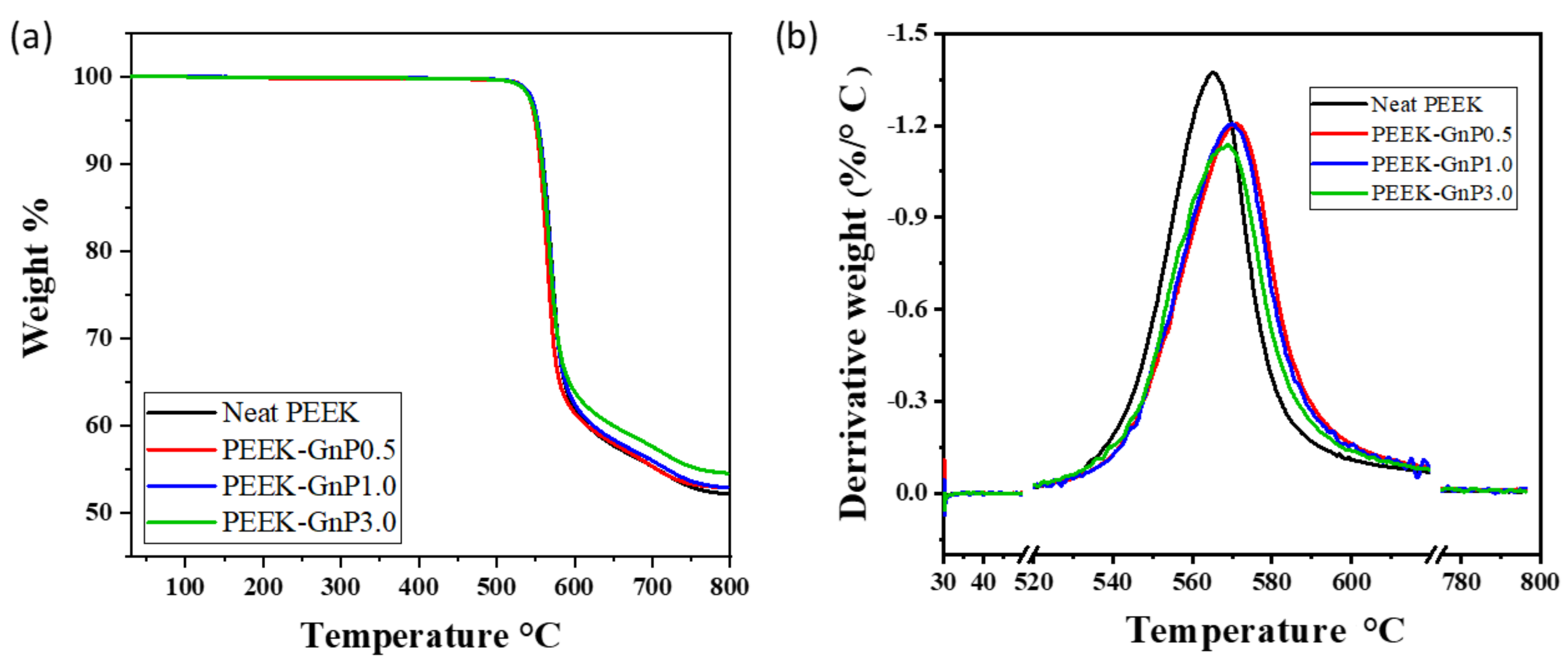
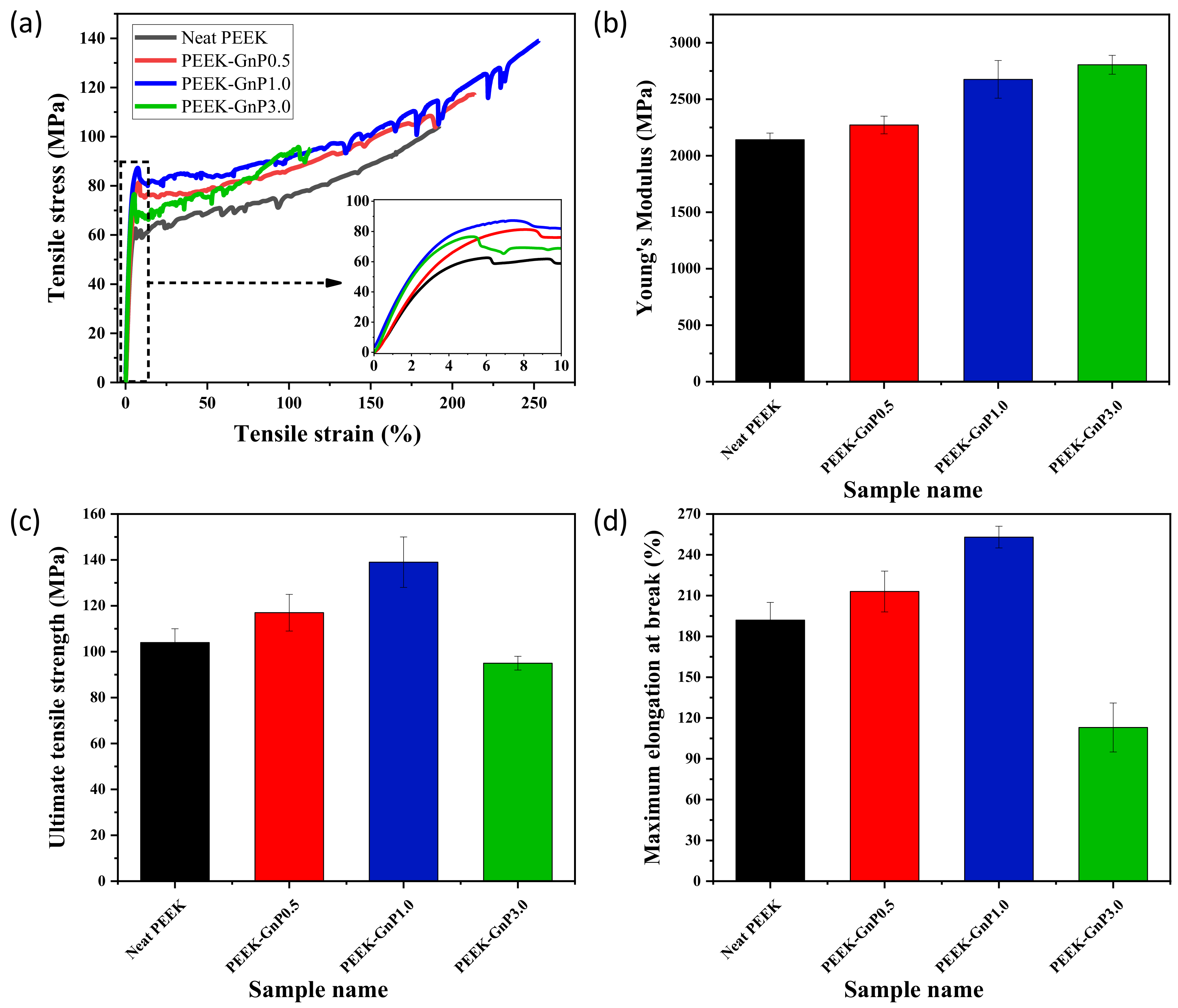

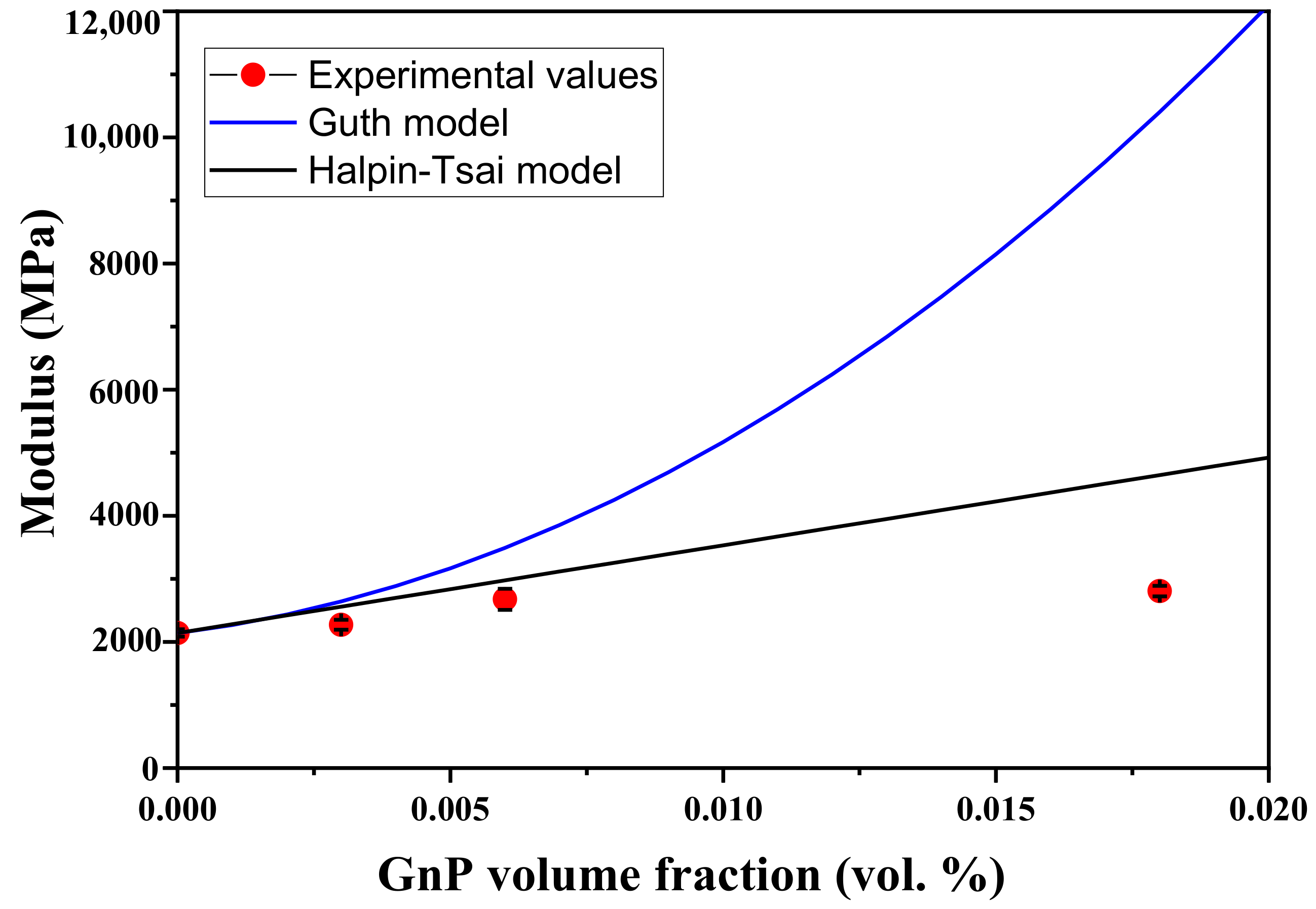
| Sample Name | Polymer Weight (Wt %) | Graphene Weight (Wt %) |
|---|---|---|
| Neat PEEK | 100.0 | 0.0 |
| PEEK–GnP0.5 | 99.5 | 0.5 |
| PEEK–GnP1.0 | 99.0 | 1.0 |
| PEEK–GnP3.0 | 97.0 | 3.0 |
| Sample Name | Xc (%) |
|---|---|
| Neat PEEK | 29.1 |
| PEEK–GnP0.5 | 28.5 |
| PEEK–GnP1.0 | 27.4 |
| PEEK–GnP3.0 | 26.1 |
| Polymer | Filler Type | Concentration (wt.%) | Improvement in Ultimate Tensile Strength (%) | Improvement in Young’s Modulus (%) | Storage Modulus (%) | Reference |
|---|---|---|---|---|---|---|
| PEEK | GnP | 1.0 | 34 | 25 | 61 | Present study |
| PEEK PEEK PEEK | GnP GnP MWCNT | 10.0 5.0 2.5 | −16 * 4 10 | 44 23 6 | - 25 - | [6] [58] [59] |
| PEEK | Modified GnP | 3.0 | 10 | 39 | - | [61] |
| PEEK | bi/tri-layer graphene | 5.0 | - | - | 29 | [18] |
| PEEK | GO | 2.0 | 0 | 4 | - | [20] |
| PEEK | CNF | 10.0 | 40 | 25 | 12 | [9] |
| PEEK | Modified SWCNT | 1.0 | 39 | 14 | 38 | [36] |
| PEEK | CNF | 15.0 | 50 | 40 | - | [62] |
| PEEK | Nano-hydroapatite rods + CNF | 32.0 | −14 * | 67 | - | [63] |
| PEEK | MWCNT | 17.0 | - | 50 | - | [13] |
| PEEK | Modified SWCNT | 1.0 | - | - | 34 | [12] |
| PEEK | Modified GO + modified MWCNT | 1.5 | - | - | 50 | [25] |
Publisher’s Note: MDPI stays neutral with regard to jurisdictional claims in published maps and institutional affiliations. |
© 2021 by the authors. Licensee MDPI, Basel, Switzerland. This article is an open access article distributed under the terms and conditions of the Creative Commons Attribution (CC BY) license (https://creativecommons.org/licenses/by/4.0/).
Share and Cite
Yaragalla, S.; Zahid, M.; Panda, J.K.; Tsagarakis, N.; Cingolani, R.; Athanassiou, A. Comprehensive Enhancement in Thermomechanical Performance of Melt-Extruded PEEK Filaments by Graphene Incorporation. Polymers 2021, 13, 1425. https://doi.org/10.3390/polym13091425
Yaragalla S, Zahid M, Panda JK, Tsagarakis N, Cingolani R, Athanassiou A. Comprehensive Enhancement in Thermomechanical Performance of Melt-Extruded PEEK Filaments by Graphene Incorporation. Polymers. 2021; 13(9):1425. https://doi.org/10.3390/polym13091425
Chicago/Turabian StyleYaragalla, Srinivasarao, Muhammad Zahid, Jaya Kumar Panda, Nikolaos Tsagarakis, Roberto Cingolani, and Athanassia Athanassiou. 2021. "Comprehensive Enhancement in Thermomechanical Performance of Melt-Extruded PEEK Filaments by Graphene Incorporation" Polymers 13, no. 9: 1425. https://doi.org/10.3390/polym13091425







